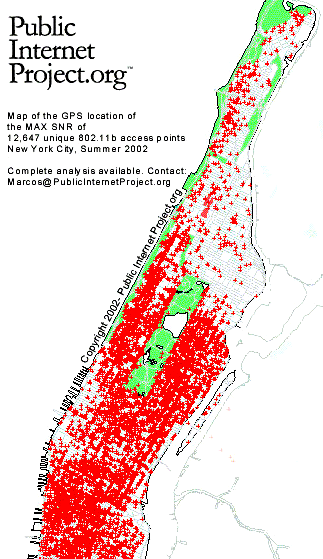- the equipment does not require a license to operate
- standardization allowed many competing manufacturers to enter the market
As people became familiar with WiFi and equipment prices dropped, they began deploying "hotspots" in public areas. Hotspots were deployed in stores, restaurants, hotels, chains like Starbucks, airport lounges, etc. Some businesses charge for access and others are offer it free as a convenience for customers. The cost of a hotspot was low, and in many cases a business used their existing Internet connection for a backhaul connection to the Internet.
WiFi caught on, and the map on the left shows the WiFi access points in Manhattan by the summer of 2002.
Soon city governments began installing hotspots that covered open areas like parks or limited downtown districts. Outdoor hotspots are more difficult to create than those indoors because equipment must be weather proof and backhaul must be provided.
Google estimates the cost of a municipal network in Mountain View California, their headquarters city, at $1 million.
There are many public hot spots. You may be able to find one near your home by searching here or here.
Hotspots are often installed by user groups and other volunteers. Active wireless users groups include:
- LA area
- Southern California
- Seattle
- The San Francisco Bay area
- New York
- World-wide, quasi commercial
- Class blog entry on municipal networks.
- Muni-wireless reports on municipal networking.
- Freepress maintains a map and description of community and municipal networks in the US.
- Hear an NPR discussion on municipal networks.
- Read what President Clinton's former chief of staff, John Podesta has to say on the topic.
- AT&T (SBC) lobbying to outlaw municipal networks, a roundtable discussion
- AT&T (SBC) contributions to congressmen in an effort to outlaw municipal networks
- Listen to San Francisco moves closer to free wi-fi from American Public Media.
